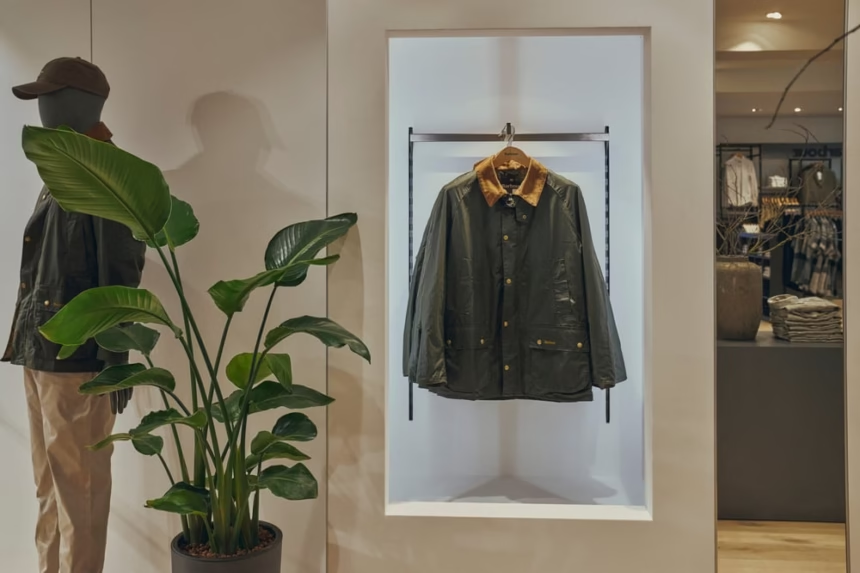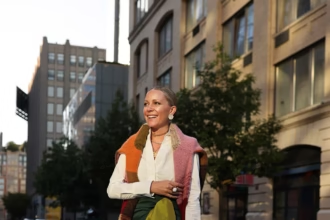By
Bloomberg
Published
October 10, 2025
Although it took until October, fall has finally arrived in New York City. The signs are everywhere: The streets no longer harbour that rich, gourmet cheese aroma of rotting garbage. Everyone says they’re excited to make dinner plans, but no one has an open evening until November. High school kids have taken over subway cars in their elbowy scrums, always shouting. And, of course, the finance bros have broken out their Barbour jackets.

The last is probably the most subtle shift, but it may have the longest lineage. A Northeastern preppy tradition that stretches back, like so many do, to Britain, Barbour apparel can trace its heritage to 1894, when Scotsman John Barbour launched a business selling oilskins to sailors and fishermen who worked in the rugged weather of northeastern England. In the 1930s the brand’s outerwear became a standard uniform for motorcyclists and the British submarine service. Later, the company received a royal warrant for its regular use by kings and queens as they stomped around in muddy wellies on Scotland’s perpetually damp Balmoral estate.
Nowadays, it’s a very specific signifier of belonging to a certain class- worn by folks for whom work almost never involves exposure to bad weather. A classic coastal shibboleth, the older a Barbour appears, the more powerful a signifier it is. A rough square of mending stitches tells the tale of a long-forgotten Christmas tree incident, and faded spots on the shoulders are hallmarks of the backpack years in college. But only the wearer really knows its whole story.
A Barbour jacket doesn’t look attractive, exactly. It looks like it does a job, and well. At around $400, it’s not much pricier than, say, a Patagonia- but if you have one, there’s a strong chance your mother bought it for you, and you have been wearing it for decades. The Barbour’s oversize brass zippers never seem to snag, the soft tartan lining is warm but rarely too hot, and the collar never seems to sit exactly the right way, giving it a rakish look. If you need one with longer sleeves, Barbour will just slap on some extra inches of cotton- a practice I wish just about every other brand would adopt.
“One of the unique things about our brand is that we always hear the stories that come with the garments,” says Paul Stephan, Barbour’s vice president of marketing for North America. “‘This was bought for me by my parents or handed down for me by my grandparents.’ We’ve heard stories of a jacket that’s lasted 40, 50 years.”
Here’s the secret: People can keep their Barbours for decades because you can get them rewaxed- which, like waxing your car or polishing your shoe, boosts its water resistance, nurtures the underlying material and protects its surface from wear and tear.
You used to only be able to mail your coat in for service, or bring it to a Barbour or Orvis store. But now you can drop it off at a wide array of retail locations, including Nordstrom, and get it shipped back to you in about about four weeks- a faster turnaround time than a few years ago. You can also take it to the Barbour boutique located in Washington’s Georgetown neighbourhood or on New York’s Upper East Side and watch it be waxed before your eyes. (The store clerk will put it on a heating table and spread hot wax on it with a sponge. It takes about 15 minutes total and is uncannily soothing to witness, like watching that old Mister Rogers video of how crayons are made.)
Every year in late September, I try to remind people through a post on Instagram to rewax their coats. Many followers respond with, “What are you talking about?” But a select few will say, “Thank you, I usually remember when it’s too late.”
This little secret is becoming more widely known as shoppers become more attracted to items with real patina- the signs of use and love. Over the summer, GQ published an article about how Gen Z shoppers are snatching up weathered LL Bean Boat and Totes for hundreds of dollars. Original Boat and Totes cost all of $40, and beating them up is free, so this was a surprise to me. Who knew my mudroom closet contained thousands of dollars worth of merchandise?
In my house, we have a surfeit of Bean Bags, but our inner Northeastern cheapskates won’t let us throw any away. Once, as a housewarming gift a decade ago, someone gave my husband and I a tote with our street address stitched into the side—but with the wrong building number. Obviously we still use it. And now I’m glad, because its coffee and baby formula stains, which I initially sighed over and then eventually learned to ignore, apparently make it even more valuable.
But if you’ve decided your Barbour coat has gotten too tattered for even your preppiest predilections, the company will buy it back from you for an $80 store credit. Company artisans will stitch, mend and wax it back together and then sell it again as part of the “Re-Loved” program that launched in 2019. Sometimes they’ll employ contrast-colour patches and tartan on the exterior to give the garments even more personality. Thousands of jackets, which start at $325, have been sold through the program, the company says.
“We’ll take in that jacket, clean, repair it to make it feel like new again. But it comes with the character that it was preowned, and there is such a big market for that nowadays,” Stephan says. “Shoppers will come straight to Re-Loved sometimes, in part because it’s a more approachable price point. Talk about a younger, let’s say, a college consumer: They’re shopping second hand anyway. This lets us be part of the conversation.”
In a partnership that began this year, designer Paul Smith made his own line of Re-Loved Barbours as part of his “Paul Smith loves Barbour” collection, featuring purple patches, jaunty oversize cuts, and, of course, stripes.
This glorification of the well-worn reminds me of when I was a kid, and I thought nothing was cooler than going in the back of my dad’s closet and wearing his butter-soft, beat-up jeans from college. I have squirreled away some of my own worn-in denim for my daughter for exactly this reason—she and her friends are going to look at the rectangular iPhone outlines etched into the left thigh of each pair and screech with laughter to one another through their brain computers. I can’t wait.
Of course, denim purveyors have been trying to replicate the knee tears and the lap creases of long-term use for decades. But when patina is applied in a factory, it rarely looks real. That’s part of the appeal of Levi Strauss & Co.’s Secondhand program, which the brand introduced in 2020. Leadership wanted to boost the life of its rugged denim by buying some back and offering it at lower prices—character, at a discount.
There are similar re-loved programs from American companies including Coach, Carhartt, Patagonia, Arc’teryx and Filson. They’re aimed squarely at Gen Z and millennial consumers who say they shop based on sustainability and durability.
Indeed, with the rise of resale sites in recent years, and Gen Z’s love of them, a younger generation has gotten hip to things that look old. Even in handbag and watch collecting, where for many years finding something in mint condition- which promised the best resale value- reigned supreme, now serious collectors scour eBay and other vintage sights for watches that have unique signs of wear.
“I think younger people are so tired of all the digital stuff. Everything around them is digital. Obviously this is why they feel nostalgic for a pre-technology time. And preowned and vintage anything hearkens back to that,” says Tony Traina, the author of a popular Substack called “Unpolished.” The name refers to the current trend in watch collecting that favours timepieces in their original configuration, even if that means it’s slightly scuffed, and not polished or updated to look perfect. “Collectors appreciate the wear that comes naturally with these types of watches and- and are loving that and putting a value on that- instead of things looking all artificial and minty.”
I recently got an old 1956 Girard-Perregaux watch fixed up at WatchCheck and wrote on the instruction sheet “DO NOT POLISH.” Its uneven Speidel bracelet, once gold-toned but now rubbed over the course of decades to a shiny hay colour, is my favourite thing about the watch. And last week, I got my Barbour rewaxed at the Madison Avenue store in Manhattan- where I learned that throughout the fall there are customisation pop-ups at Bloomingdale’s stores in New York, Chicago and Norwalk, Connecticut where Re-Loved items will be sold. The designs are very cute.
I recommend you go and check out one of the pop-ups. That way, when your friends compliment you on your distinctive new jacket, you can say, “What, this old thing?”









